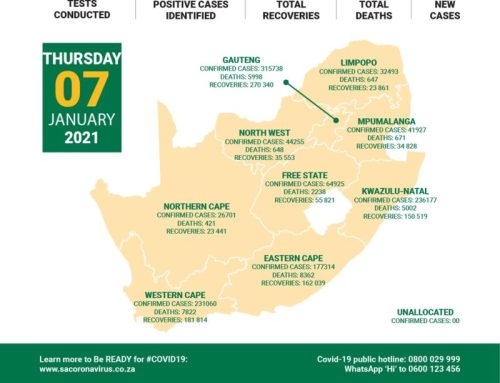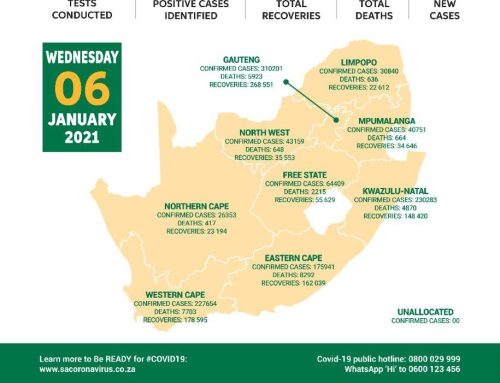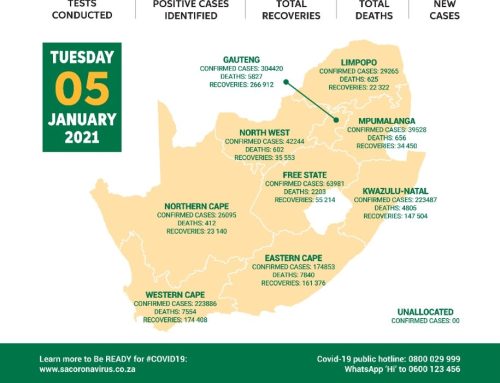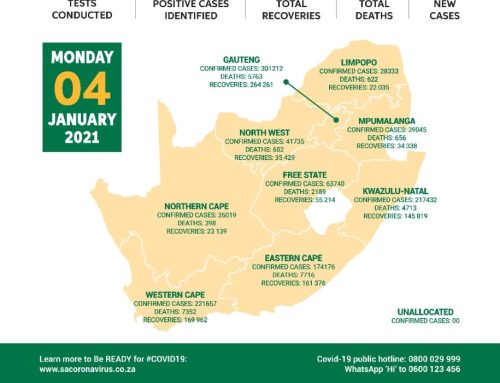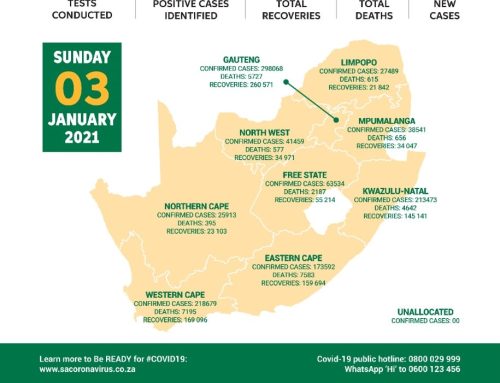28 April 2020
Increasing COVID-19 numbers and analysis thereof
It has been nearly 8 weeks since we reported the first case COVID 19 in the country on 5 March 2020- it seems like an age since we made that historic trip to a small boys’ school in KZN, Cowan House.
At that stage, we had hoped for a less dramatic turn of events. But South Africa belongs to
a global community and, as head of the World Health Organisation Dr Tedros Adhanom
Ghebreyesus warned not long after: no-one would be immune from the devastating effects
of the Coronavirus.
Thus, South Africa continued to import more cases of COVID-19 and it was not long before
local transmission began to set in. On 27 March we made the difficult decision to place the
country under lockdown in the interest of mitigating worse socio-economic outcomes.
What was to be a 21 day lockdown was extended to 35 days of lockdown.
At this point, I would like to extend my sincere gratitude to all South Africans for your faith,
trust, support, tenacity and generosity.
Our stewardship is only as good as your confidence in us- you have really shown the world
that through social solidarity and meaningful partnership with government, it is possible to
beat the odds and come out stronger together!
As of this morning, the pandemic still shows no signs of easing on its global sweep- there
are now cumulatively over 3 million cases globally, with the USA having tipped the million
mark therefore suffering a third of the worlds burden.
Over 210 000 have succumbed and 916 986 have recovered. China has long relinquished
the title of being the “epicentre” of the outbreak and is now number 10 in the world.
If you read Chinese news, COVID-19 now occupies the back pages of their publications
and they have resumed with progressive headlines such as the space race and launching of
driverless e-hailing taxi’s.
Here at home we currently we’re also seeing an increase in our numbers. As of today we
have 4996 cases reported in South Africa. The number of tests that have been conducted
comes to 185 497.
The provincial breakdown is as follows:
| GAUTENG | 1337 |
| WESTERN CAPE | 1870 |
| KWAZULU – NATAL | 919 |
| EASTERN CAPE | 616 |
| FREE STATE | 113 |
| LIMPOPO | 31 |
| NORTH WEST | 29 |
| MPUMALANGA | 24 |
| NORTHERN CAPE | 17 |
| UNALLOCATED | 0 |
Of late we have been able to clear all the unallocated who were part of an administrative
challenge we were going through.
At this point we would like to sadly report that there have been three more deaths today
bringing the total to 93 deaths. The three deaths have happened in the Western Cape:
• A 67 year old male
• 70 year old male
• 79 year old female
All of them did have underlying conditions.
We wish to convey our condolences to the families of the deceased and thank the health
care workers who attended to these patients before their passing.
It is important for us to indicate that we are very proud of the work that is being done by our
professionals, in particular those who are in the frontline, in the hospitals, in the laboratories
both in the public and in the private sector.
Studies continue to consistently demonstrate a strong association of adverse outcomes
(that is serious illness or death) from COVID-19 infection with pre-existing co-morbidities.
The three that are currently emerging to be the most commonly associated co-morbidities
are hypertension, diabetes and obesity. Lung disease such as asthma and chronic
obstructive airways disease, commonly seen in smokers, are also important pathologies.
Age over 63 is an important factor.
In our country we have a significant burden of all these issues:
• More than 1/3rd of South Africans are suffering from hypertension and Wits University last
year revealed that we have the highest prevalence in Southern Africa as well as the
largest number of people who are not well controlled, even with treatment.
• Around 4.5 million people in South Africa have diabetes
• Over 70% of women and 40% of men in South Africa are overweight or obese
These risk factors are important to take into account because they play a role in the
conduct of COVID 19.
We still have an unknown risk factor of HIV and AIDS, which other countries have not been
able to study. With the largest burden of people living with HIV, South Africa, unfortunately,
will be the definitive country to assess the extent of HIV co-mordity in COVID-19 outcomes.
Therefore, as you can now all appreciate, we cannot afford a rampant spread of COVID-19.
Our low mortality rate (1.9%) has largely been attributable to the fact that most people to
date that have acquired COVID-19 are healthy, young individuals. Indeed just about all the
patients who did pass away did have the above underlying conditions. Therefore a spillover
into these large population groups will lead to disastrous consequences for us, like the
excessive mortality rates of up to 14% we are seeing in Western Europe.
We must therefore continue to be highly vigilant and continue to prepare in earnest.
Modelling
Statistical modelling is at the very core of the COVID-19 outbreak response.
We have tapped into the very best intellectual resources for this make or break task. We
have engaged the country’s top universities and research centres who have long and
prolific track records in statistical modeling and future determination. The South African
COVID-19 modeling consortium is composed of:
• Modelling and Simulation Hub, Africa (MASHA), University of Cape Town, South Africa
• South African DSI-NRF Centre of Excellence in Epidemiological Modelling and Analysis
(SACEMA), University of Stellenbosch, South Africa
• Health Economics and Epidemiology Research Office (HE2RO), University of the Witwatersrand, Johannesburg, South Africa
• Boston University School of Public Health, US
• National Institute for Communicable Diseases (NICD), South Africa
We were presented with various scenarios and an analysis of the projected impact of
different types of intervention.
When we looked at the intervention of lockdown the important question we had was for
how long would a lockdown be needed to have its desired impact. What the models
ultimately demonstrated is that, over time, the effects of a lockdown begin to wane and
there does come a point where the adverse effects of a lockdown outweighs the benefits.
It was on this basis that we undertook a defined lockdown period and we are very satisfied
that it has yielded the results we had hoped for- that is to flatten the curve such that the
health care system is not overwhelmed.
In addition it has allowed us to ramp up the machinery of the health services to a point
where we can attain the high screening and testing numbers that we have.
It is important to remember that the response requires agility and flexibility which is why we
are working on an alert system. We can now move between lockdown stages or lockdown
certain hotspots (the putting out of small fires) as was done in China which locked down
Wuhan and other epicenters. Now China has no lockdown areas within the country and
they have maintained a flat curve.
The Government has fully appreciated the socio-economic consequences of lockdown and
how this could affect general moral and sentiment in the country. And so the issue of
opinion polls can muddy what is essentially a delicate exercise of balancing the
preservation of health and life with the preservation of the economy.
We have noted the City Press article that cited a “plummet” in support for a lockdown,
however we wish to indicate that we are acutely sensitive of issues around food security,
job security, poverty and all matters pertaining to human prosperity.
We wish to reassure the nation that the hard decisions we have had to make were based on
sound scientific evidence of which we can say that, at this stage, we have prevailed over
the threat as a nation that has made the necessary sacrifices to be able to achieve this.
PPE
The issue of PPE’s continues to be a moving target as various factors lead to challenges in
the movement of and ability for provinces to acquire stock. The Department is working on
improving data capturing and I urge the provinces to comply with the new reporting
mechanisms that have been implemented. With a worldwide stock challenge of PPE’s it is
critical for us to manage this with the utmost efficiency
We really must express appreciation to Business for South Africa which has acquired PPE’s
to the tune of 41 million pieces of PPE and has an order book to the value of 1 billion rand.
We thank the myriad of small and medium enterprises that have come forward with PPE
stock and manufacturing. To date 281 suppliers have been approved on the B4SA portal
out of over 1000 that have registered. We continue to call on businesses that manufacture
and stock PPE to register on the B4SA portal, and make a particular call to black owned
enterprises to seize the opportunity.
We also wish to recognize the recent donations coming from Naspers, First National Bank,
United Pharmaceutical Distributors, the People’s Republic of China, the World Health
Organisation, Ford Motor Company, and the Solidarity Fund.
I would like to re-iterate that South Africa has adequate PPE stock for about 6-8 weeks and
DTI continues to work towards ramping up our manufacturing capabilities.
But as we continue to face challenges of PPE security due to factors such as surges in
global demand and price gouging, we have decided to strengthen the Occupational Health
and Safety Committee to engage stakeholders, perform oversight work including the
auditing of stock.
This issue is becoming critically important as we have seen a number of health care
workers acquiring COVID-19 in the workplace: today we have 324 cases of COVID-19
amongst health professionals. We take this issue very seriously as a Department and we
wish to assure our colleagues and stakeholders, particularly the unions, that we are
committed to protecting the safety of our health care workers.
Human Resources for Health
Contingent in the package of support the President announced for the strengthening of the
health sector during the outbreak, was the issue of capacitating human resources for
health.
Prior to the outbreak you will recall this was the first Pillar of the Presidential Health
Compact and work had already begun to yield results. At the end of last year we ensured all
interns had been placed to begin work in 2020 and this was followed by the placement of
all community service officers.
Government made an undertaking that every single doctor must be employed and treasury
remains determined to ensure that this is attained.
Therefore any doctor who is currently unemployed or may be having difficulties in the
private sector due to the lockdown is encouraged to contact their respective provinces.
We extend the call to all health professionals, even those who are retired, to come forward
and take up employment- even if it is for the short term.
We must however re-iterate that we cannot employ health care workers who are not
registered with the relevant authorities.
Deployment of Cuban Doctors
At the stroke of midnight on Monday morning a 217 strong Cuban medical brigade touched
down on South African soil.
A legacy of the wonderful history of brotherhood we share with Cuba, this brigade has
responded to a call made by his Excellency President Cyril Ramaphosa to Cuba for
assistance as we prepare for the peak of the epidemic to come.
These professionals have come here to augment our capabilities and they also have certain
strengths which we need, for instance in community medicine where we are weak because
of our hospi-centric model.
Our mutually beneficial relationship with Cuba has a long history and will continue to be one
of our strengths as a nation. This year there will be about 700 medical students graduating
in Cuba.
This brigade does not threaten job security for our own health care workers but have rather
come to strengthen our human resources capacity.
Contingent in the brigade is much needed expertise in Family Medicine, Case Management,
Regulation, Epidemiology, Health Technology and Biostatistics
The provincial deployment breakdown has been circulated in a powerpoint presentation
entitled “COVID-19 Health Media Briefing Presentation April 28 2020.”
We thank the President for reaching out to Cuba and other countries for this assistance and
we look forward to a very fruitful working relationship with our colleagues from abroad.
ENDS

